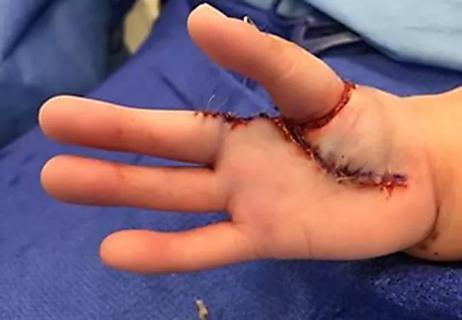Noninvasive treatment may slow progression of Dupuytren's disease and plantar fibromatrosis

Dupuytren's disease (DD) and plantar fibromatosis (PF) are proliferative conditions that cause painful benign nodules to form on the palms of the hand and soles of the feet. In recent years, many patients have experienced symptom relief after receiving radiation therapy (RT), yet there remains limited awareness in the medical community about this treatment option for early-stage disease.
Advertisement
Cleveland Clinic is a non-profit academic medical center. Advertising on our site helps support our mission. We do not endorse non-Cleveland Clinic products or services. Policy
Roughly 3-5% of the U.S. population suffers from DD, while PF is rarer, affecting fewer than 200,000 people across the country. People who have one of these abnormalities are also prone to the other. It's unclear the exact reason or etiology of why these conditions form, but once they do, they can impact a patient's quality of life. DD and PF cause nodules that progress into painful contractures or tightening in the hands and feet, limiting day-to-day function.
“One of the big challenges is that there's a general lack of awareness in the medical community about the disease process and the treatment options, particularly radiation therapy as an important option to prevent progression into a more debilitating form once contractions develop,” says Rahul Tendulkar, MD, Staff Physician in the Department of Radiology Oncology at Cleveland Clinic Cancer Institute.
Primary care providers often have little exposure to the treatment of DD and PF. Part of the issue is that patients may consult with different specialists for each issue. They commonly see a hand surgeon for Dupuytren's disease or a podiatrist for plantar fibromatrosis. “If one specialist sees a problem on the hand, they may not even ask about the person’s foot or vice versa if they’re not aware this condition may occur there,” says Dr. Tendulkar.
Historically, these conditions were often only treated once a nodule progressed into a contracture of the fingers or toes. Surgical intervention was one of the few alternatives, but this invasive option often wasn't effective at treating the underlying condition.
Advertisement
Thus, patients could lose the use of a hand or foot for weeks during recovery, only to have the nodules recur in many cases. Other treatment options include collagenase injections or a needle aponeurotomy to break down the abnormal tissue, but these methods have similar shortcomings. Thus, there has been an interest in trying to manage the conditions earlier in the process of disease development.
A small multicenter, double-blind, phase 3 trial in Europe found RT to be an effective treatment for symptomatic PF, with over two-thirds of patients reporting notable improvements in pain reduction and walking function. The Department of Radiation Oncology at Cleveland Clinic Cancer Institute has been offering this mode of therapy to dozens of DD and PF patients each year.
RT can improve symptoms as well as treat the underlying disease to a degree. Once nodules form, though, it's unlikely RT will completely eradicate them. However, if used early, it can halt or delay the progression into a more symptomatic form of the disease.
Beginning intervention earlier is beneficial, says Dr. Tendulkar. "Ideally, when we use radiation therapy, the patient may have nodularity of the hand but without contracture of the fingers. Treating DD before 10 degrees of contraction is considered the optimal time to deliver radiation. If the nodule has resulted in a contracture greater than 10 degrees, it's unlikely that radiation will reverse that.”
For these conditions, RT is found to be generally very safe and won’t prevent patients from undergoing surgery or other procedures if needed in the future.
Advertisement
“Historically, the main concern about radiation therapy was that there was a very small chance of a secondary cancer that could develop as a result, but naturally occurring cancers of the hand or of the foot are very rare, so the risk of secondary cancers from this type of radiation therapy is very, very low,” explains Dr. Tendulkar. “We’re not aware of any reported cases of a secondary cancer resulting from radiation therapy of these conditions.”
Generally, RT is administered to involved nodules, including a margin of tissue around the area to account for any extension of disease that may not be clinically apparent.
Radiation for DD and PF is less than half the dose administered for most forms of cancer, and it is given over a short timeframe. Typically, for DD and PF, patients receive a split course of RT of five doses in one week. They then have a two-month break, followed by daily treatments over five more consecutive days.
Learn more about RT for treating DD and PF.
Advertisement
Advertisement

Latest concepts in the surgical creation of functional, opposable thumbs in early childhood

Addressing rare disease and challenging treatment course in an active young patient

Large retrospective study suggests DOACs are safe, effective alternative to low-molecular-weight heparin in complex patient population

Study shows high rate of hematologic responses, low rate of disease progression

Bispecific antibody bridging therapy deepens durability of BCMA CAR T-cell therapy without overlapping toxicities in patients with relapsed/refractory multiple myeloma

Phase 2 study brings pivotal advances in treatment efficacy and safety for the most challenging-to-treat population

Patient with quadruple refractory multiple myeloma achieves complete response with cell therapy

Distinct baseline immune profiles can predict response and resistance to different types of CAR-T cells.